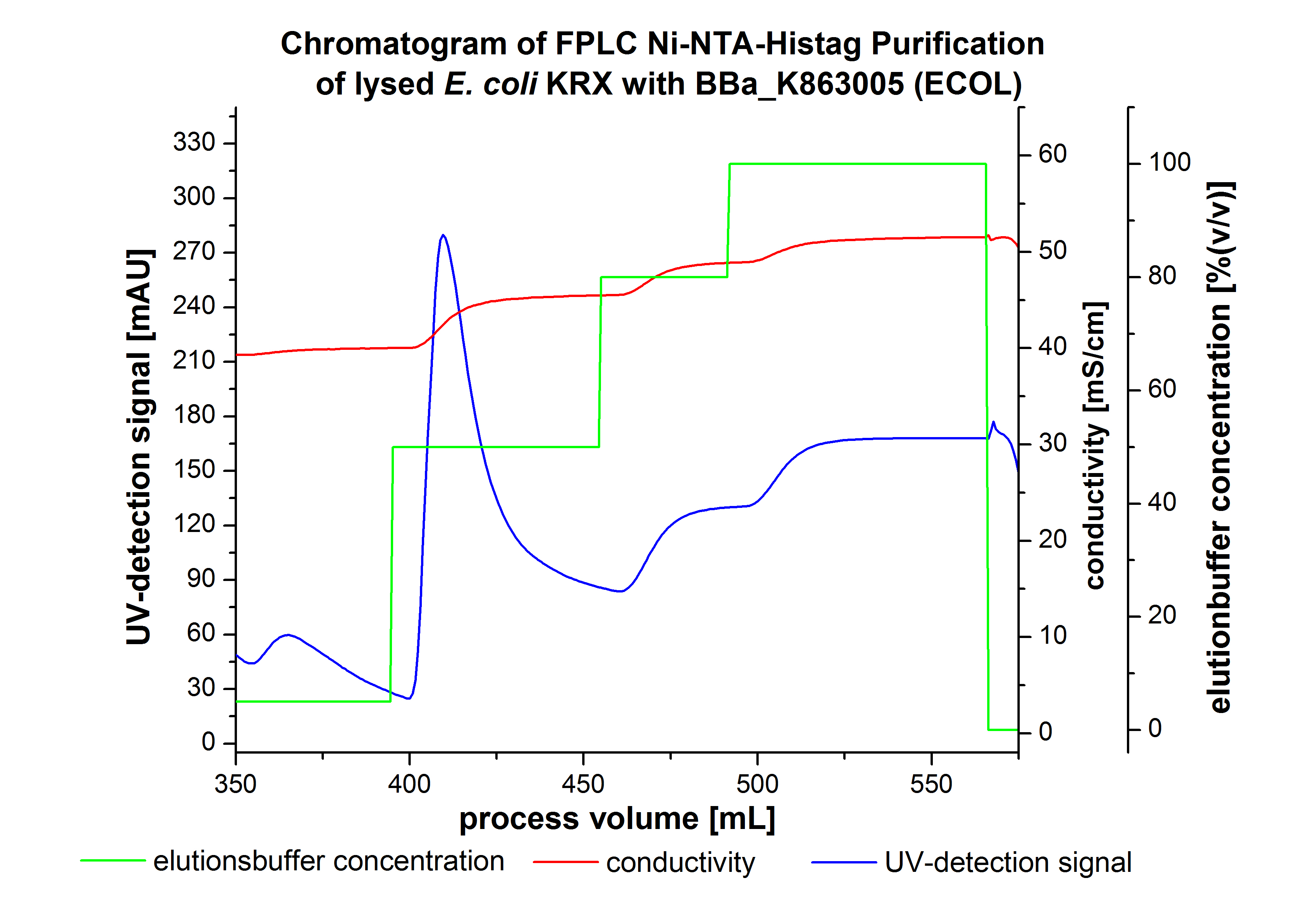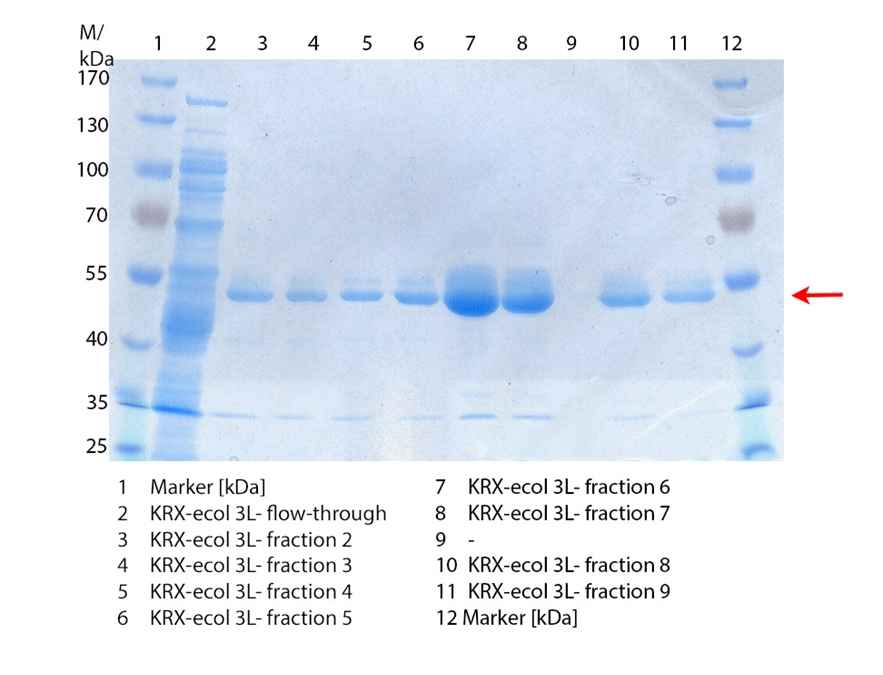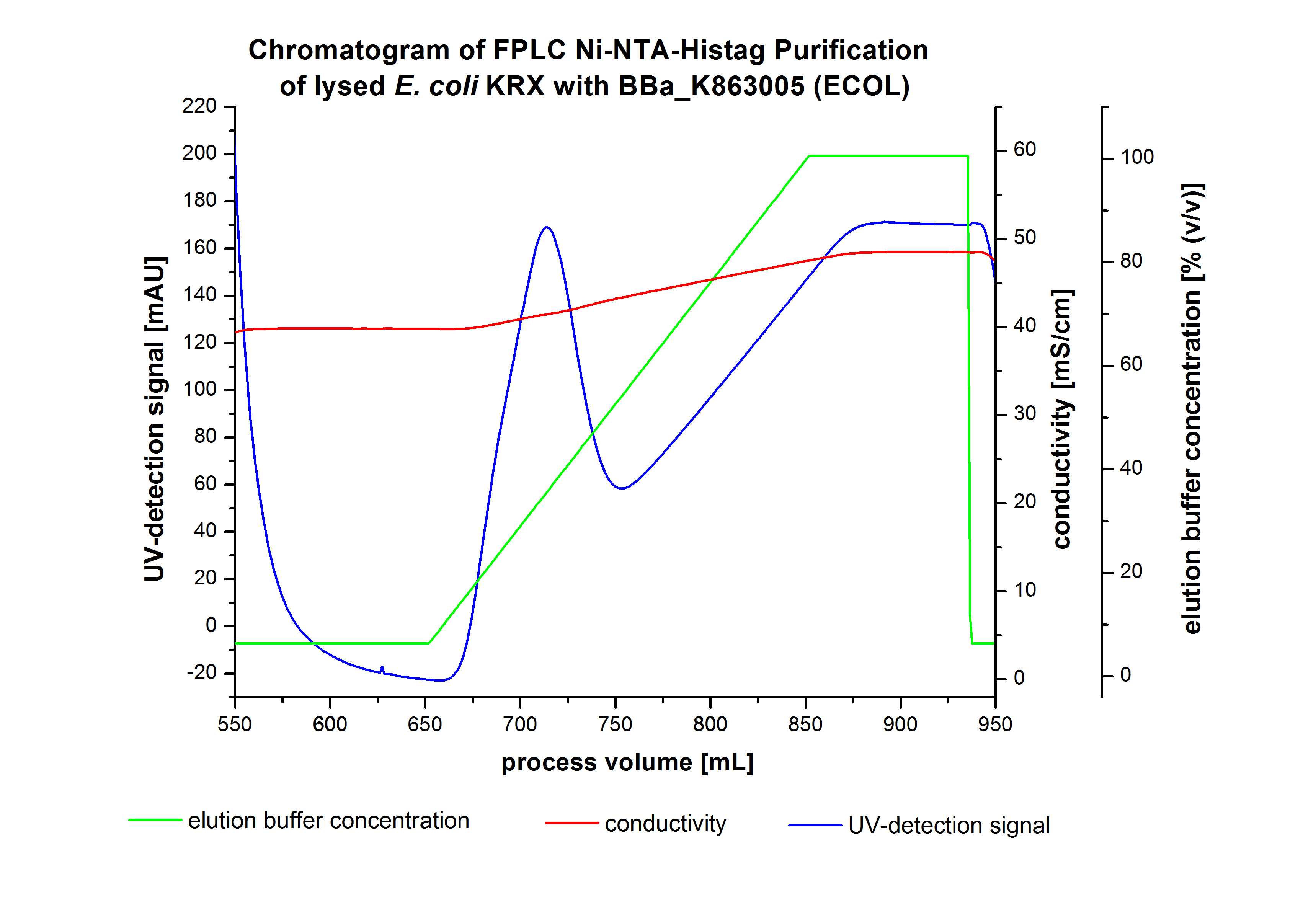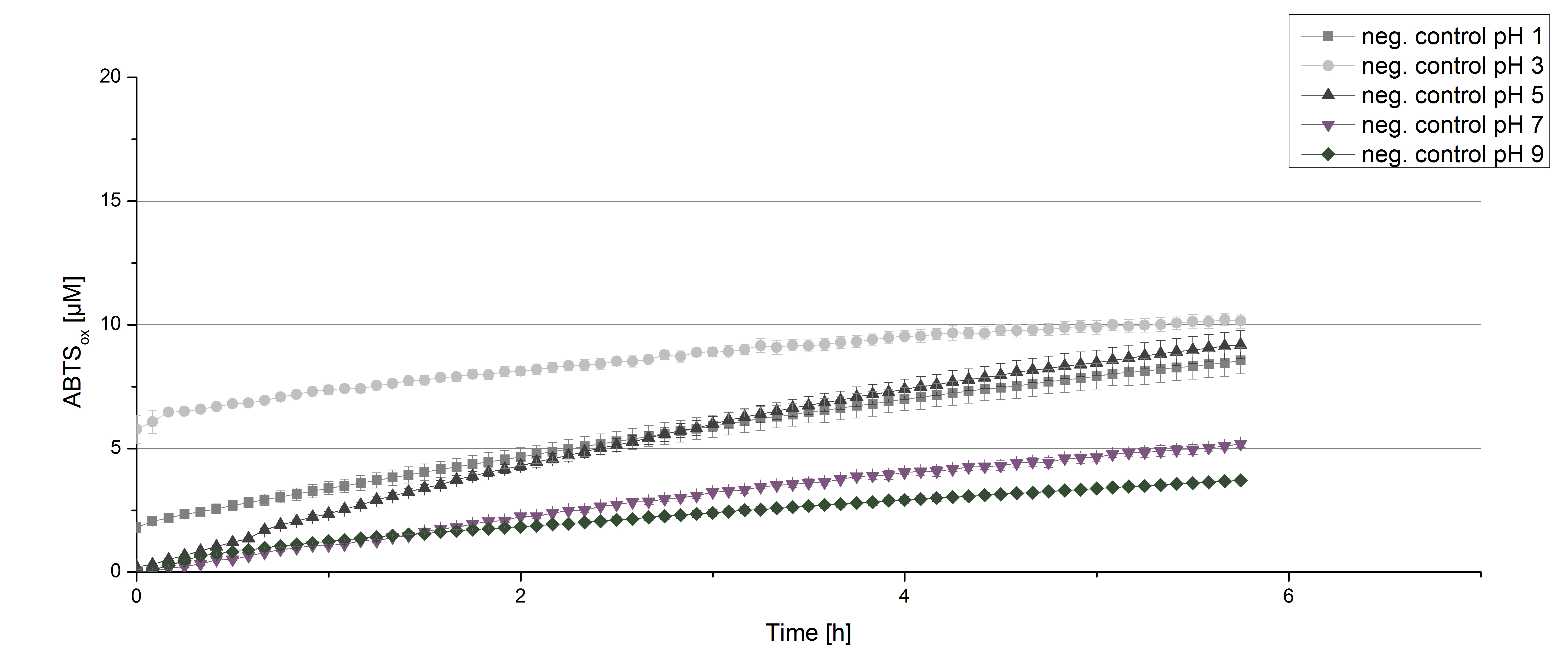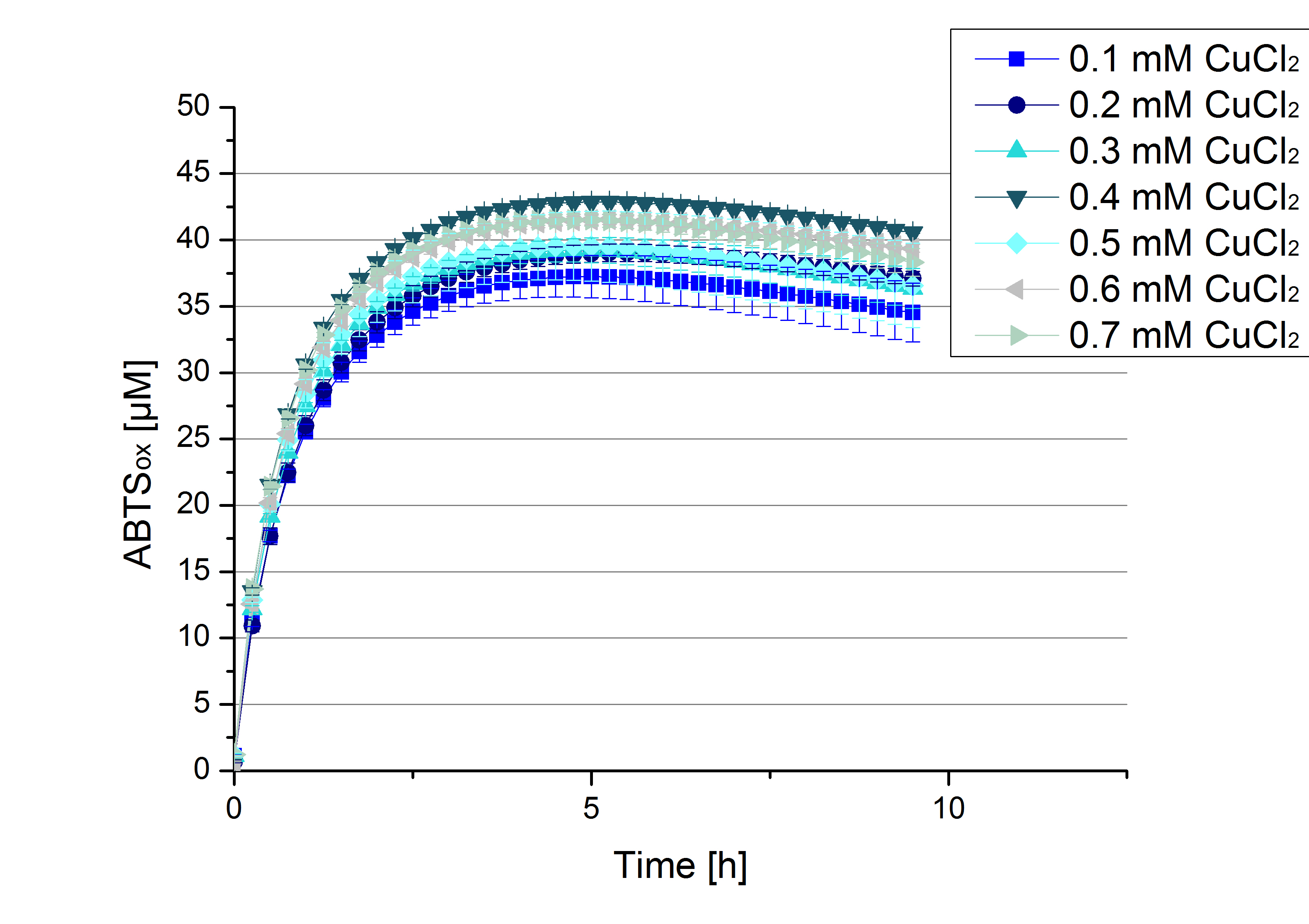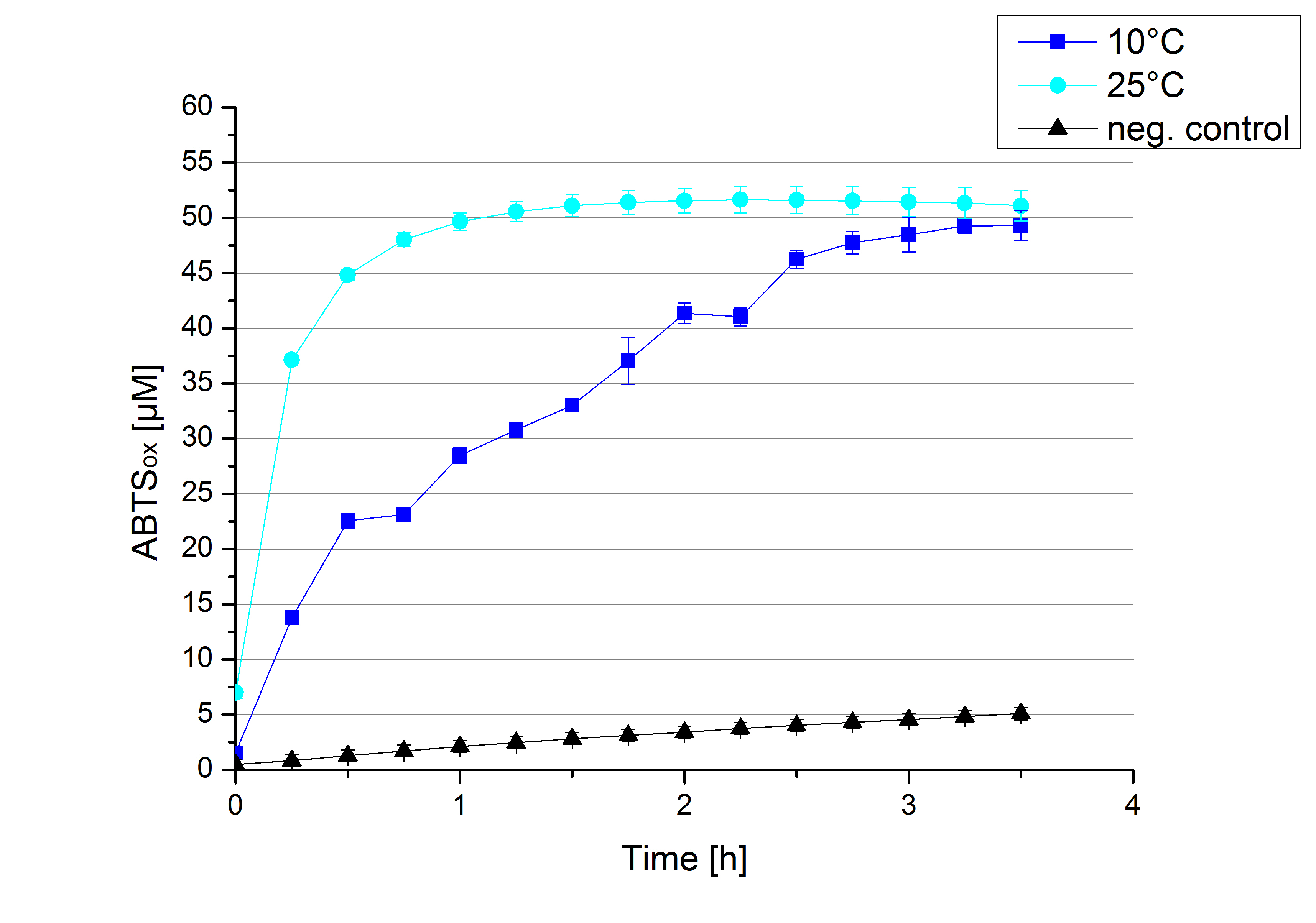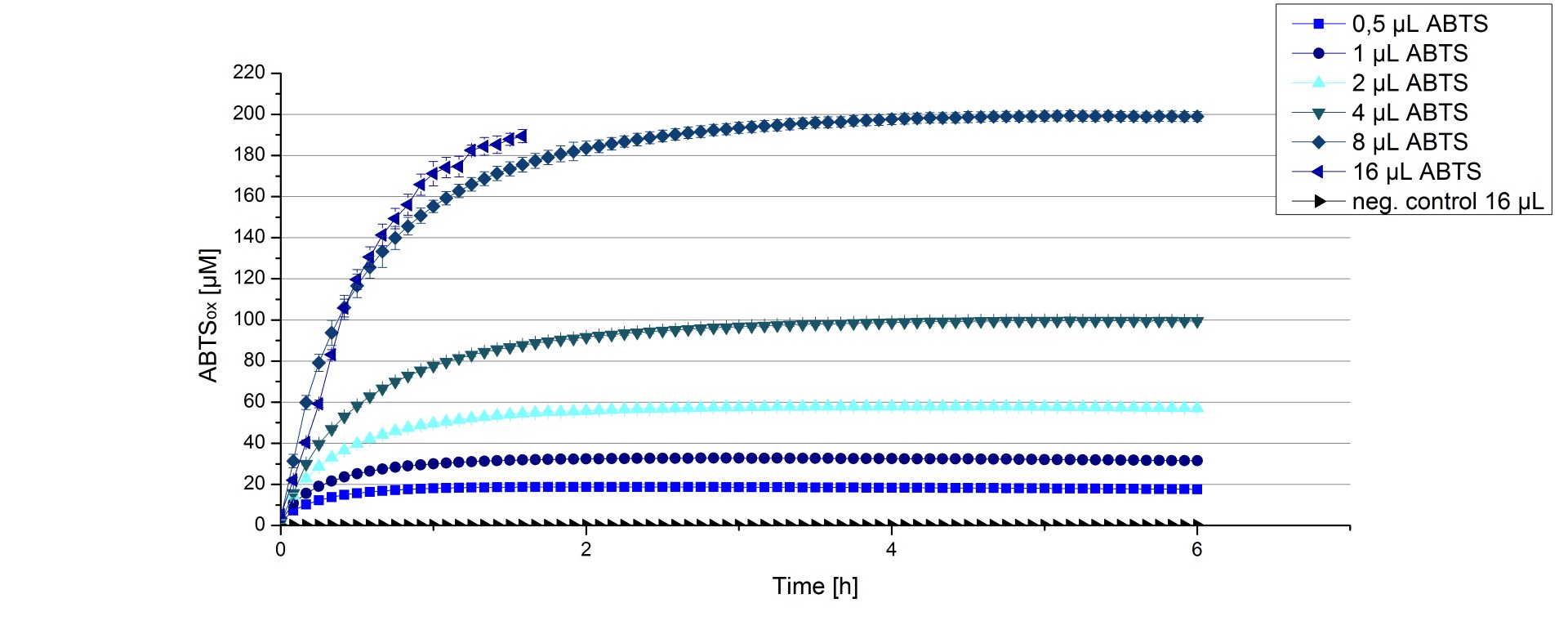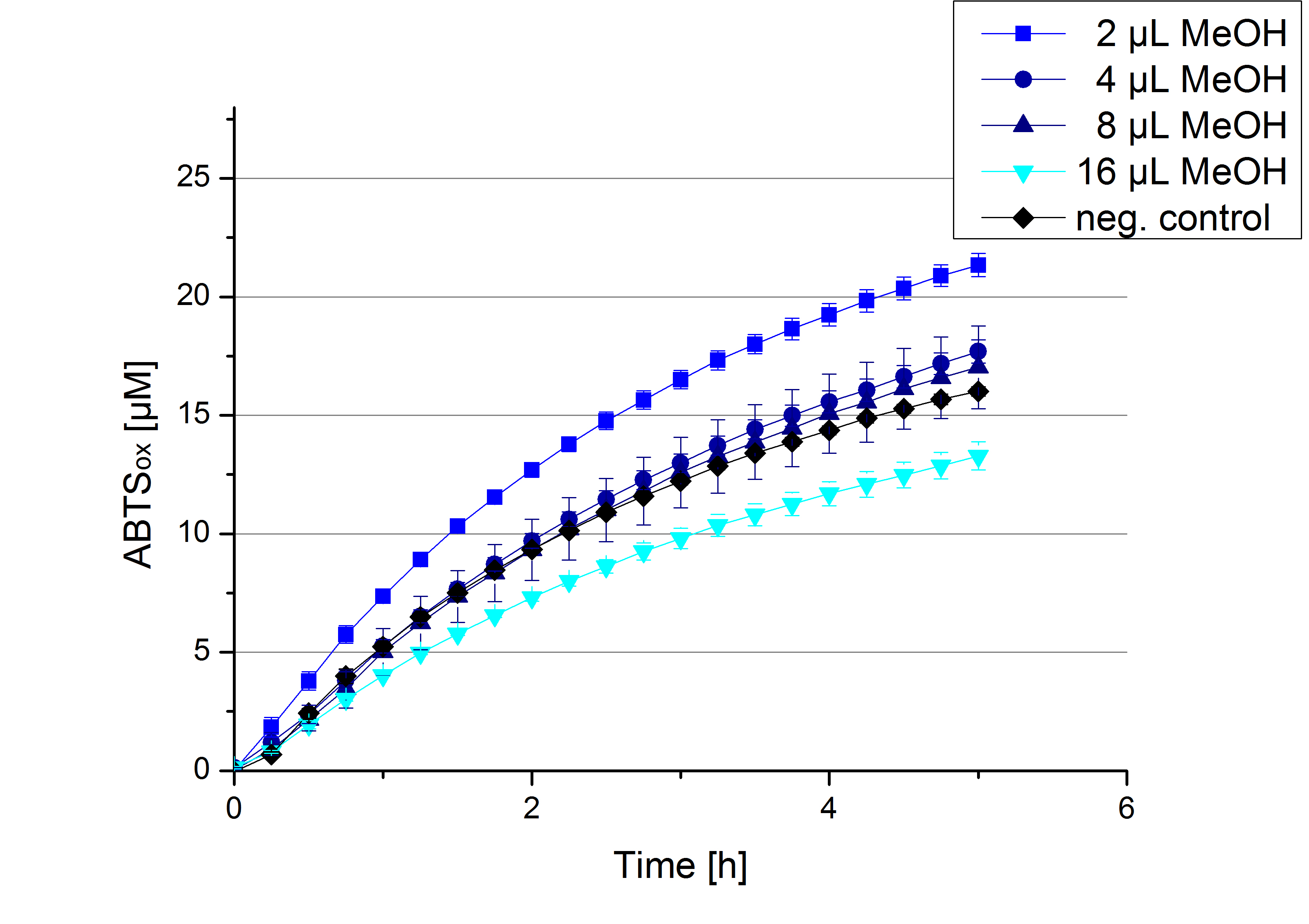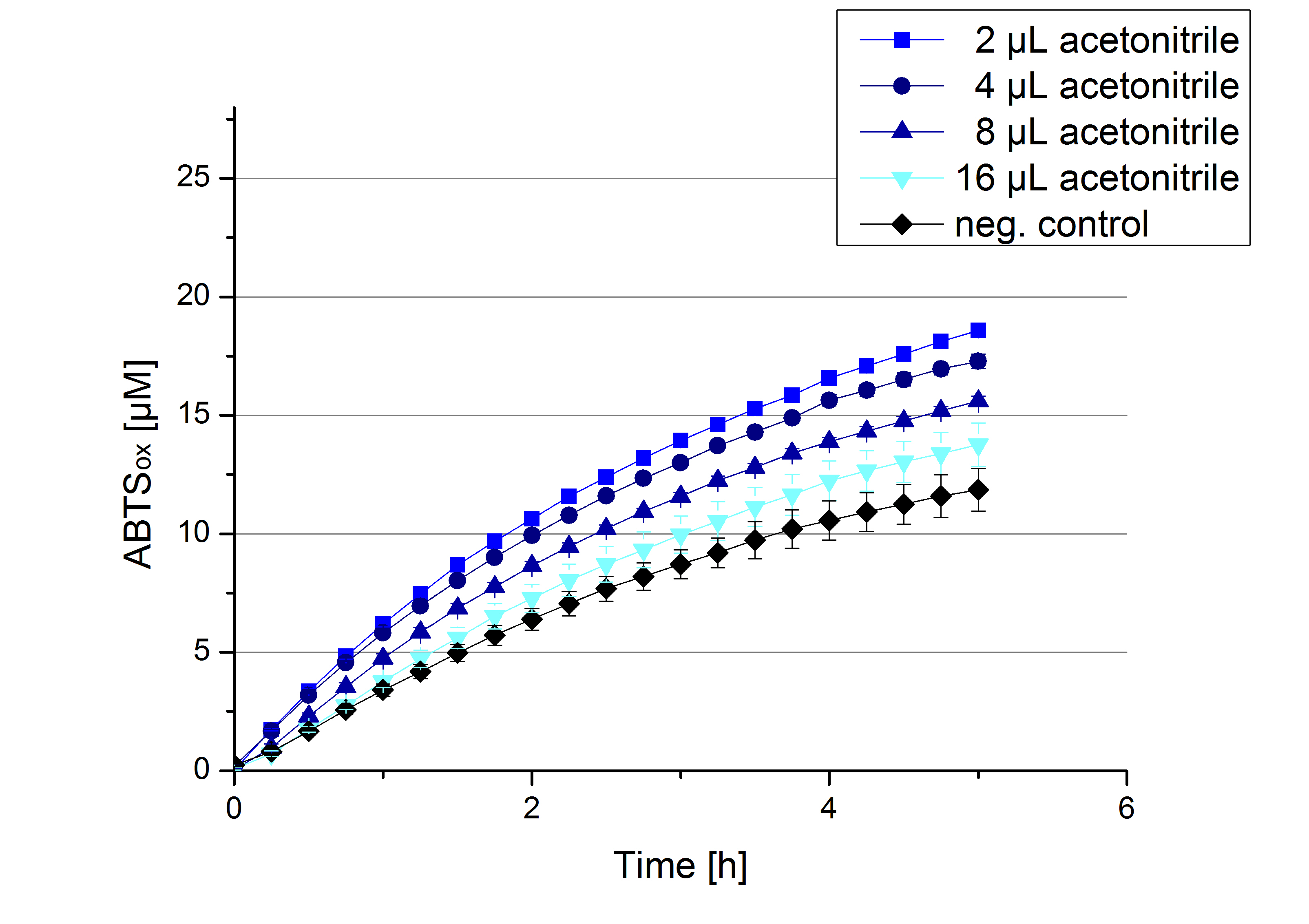Team:Bielefeld-Germany/Results/coli
From 2012.igem.org
Summary
First some trials of shaking flask cultivations were made with changing parameters to identify the best conditions for the production of the laccase CueO from E. coli BL21 (DE3) named ECOL fused to a Histag. Because of no measured activity in the cell lysate a purification method was established (using Ni-NTA-Histag resin). The purified ECOL could be identified by SDS-PAGE (molecular weight of 53.4 kDa) as well as MALDI-TOF. The fractionated samples were also tested concerning their activity. A maximal activity of X was reached. After measuring activity of ECOL a scale up was made up to 3 L and then also up to 6 L.
Cultivation, Purification and SDS-PAGE
Shaking Flask Cultivations
The first trials to produce ECOL were produced in shaking flask with various designs (from 100 mL-1 to 1 L flasks, with and without baffles) and under different conditions. The parameters we have changed during our screening experiments were temperature (27 °C,30 °C and 37 °C), concentrations of chloramphenicol (20-170 µg mL-1), various induction strategies (autoinduction and manual induction) and cultivation time (6 - 24 h). Further we cultivated with and without 0.25 mM CuCl2 to provide a sufficient amount of copper, which is needed for the active center of the laccase. Due to the screening experiments we identified the best conditions under which ECOL was expressed:
- flask design: shaking flask without baffles
- medium: autoinduction medium
- antibiotics: 60 µg mL-1 chloramphenicol
- temperature: 37 °C
- cultivation time: 12 h
The reproducibility and repeatability of the measured data and results were investigated for the shaking flask and bioreactor cultivation.
3 L Fermentation E. coli KRX with <partinfo>BBa_K863005</partinfo>
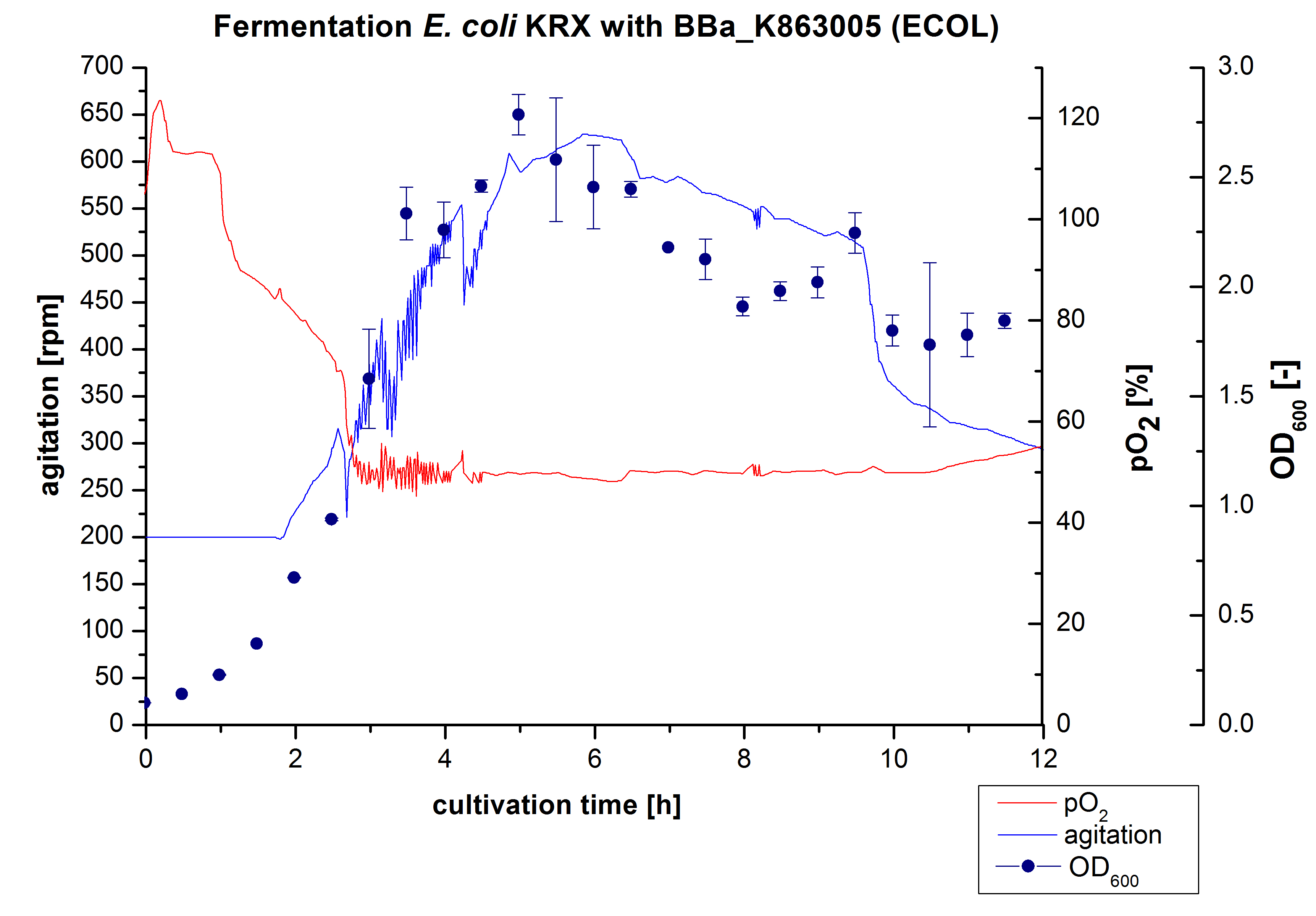
After the positive measurement of activity of ECOL we made a scale-up and fermented E. coli KRX with <partinfo>BBa_K863005</partinfo> in Infors Labfors with a total volume of 3 L. Agitation speed, pO2 and were determined and illustrated in figure 1. The exponential phase started after 1.5 hours of cultivation. The cell growth caused a decrease in pO2. After 2 hours of cultivation the agitation speed increased up to 629 rmp (5.9 hours) to hold the minimal pO2 level of 50 %. Then, after 4 hours there was a break in cell growth due to induction of protein expression. The maximal OD600 of 2.78 was reached after 5 hours. In comparison to E. coli KRX (OD600,max =4.86 after 8.5 hours) and to E. coli KRX with <partinfo>BBa_K863000</partinfo> (OD600,max =3.53 after 10 hours, time shift due to long lag phase) the OD600 max is lower. In the following hours, the OD600,max and the agitation speed decreased and the pO2 increased, which indicates the death phase of the cells. This is caused by the cell toxicity of ECOL (reference: [http://www.dbu.de/OPAC/ab/DBU-Abschlussbericht-AZ-13191.pdf DBU final report]). Therefore they were harvested after 12 hours.
Purification of ECOL
The harvested cells were resuspended in Ni-NTA-equilibration buffer, mechanically lysed by homogenization and centrifuged. The supernatant of the lysed cell paste was loaded on the Ni-NTA-column (15 mL Ni-NTA resin) with a flow rate of 1 mL min-1 cm-2. Then the column was washed by 10 column volumes (CV) Ni-NTA-equilibration buffer. The bound proteins were eluted by an increasing Ni-NTA-elution buffer step elution from 5 % (equates to 25 mM imidazol) with a length of 50 mL, to 50 % (equates to 250 mM imidazol) with a length of 60 mL, to 80 % (equates to 400 mM imidazol) with a length of 40 mL and finally to 100 % (equates to 500 mM imidazol) with a length of 80 mL. This strategies was chosen to improve the purification caused by a step by step increasing Ni-NTA-elution buffer concentration. The elution was collected in 10 mL fractions. Due to the high UV-detection signal of the loaded samples and to simplify the illustration of the detected product peak only the UV-detection signal of the wash step and the elution are shown. A typical chromatogram of purified laccases is illustrated here.The chromatogram of the ECOL-elution is shown in figure 2:
The chromatogram shows two distinguished peaks. The first peak was detected by a Ni-NTA-equilibration buffer concentration of 5 % (equates to 25 mM imidazol) and resulted from the elution of weakly bound proteins. After increasing the Ni-NTA-elutionbuffer concentration to 50 % (equates to 250 mM imidazol) a peak up to a UV-detection signal of 292 mAU was measured. The area of this peak indicates that a high amount of protein was eluted. The corresponding fractions were analyzed by SDS-PAGE to detect ECOL. There were no further peaks detectable. The following increasing UV-detection-signals equates to the imidazol concentration of the Ni-NTA-elution buffer. The corresponding SDS-PAGES are shown in figure 3.
SDS-PAGE of ECOL purification
In figure 3 the SDS-PAGE of the Ni-NTA-His tag purification of the lysed culture (E. coli KRX containing [http://partsregistry.org/wiki/index.php?title=Part:BBa_K863005 BBa_K863005]) is illustrated including the flow-through and the fractions 2 to 9. The red arrow indicates the band of ECOL with a molecular weight of 53.4 kDa, which appears in all fractions. The strongest bands appear in fractions 6 and 7. These were the first two fractions (each 10 mL) eluted with 50 % Ni-NTA elution buffer (equates to 250 mM imidazol), in which the distinguished peak appeared. The second small band with a lower molecular weight was not identified.
Furthermore the bands were analyzed by MALDI-TOF and identified as CueO (ECOL).
6 L Fermentation E. coli KRX with <partinfo>BBa_K863005</partinfo>
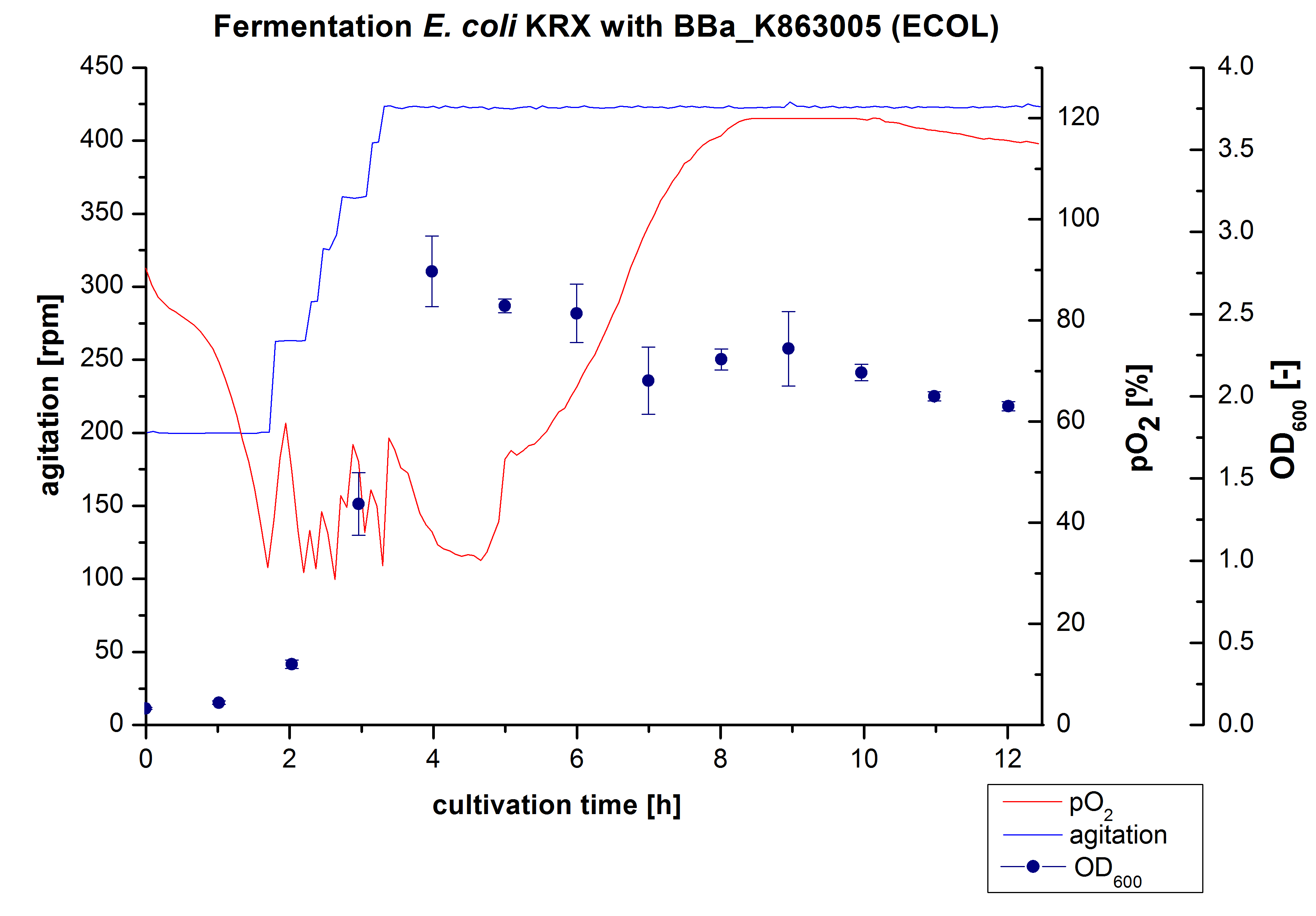
Another scale-up of the fermentation of E. coli KRX with <partinfo>BBa_K863005</partinfo> was made up to a final working volume of 6 L in Bioengineering NFL 22. Agitation speed, pO2 and OD600 were determined and illustrated in figure 3. There was no noticeable lag phase and the cells immediately began to grow. The cells were in an exponential phase between 2 and 4 hours of cultivation, which results in a decrease of pO2 value and therefore in an increase of agitation speed. After 4 hours of cultivation the maximal OD600 of 2.76 was reached, which is comparable to the 3 L fermentation of E. coli KRX with <partinfo>BBa_K863005</partinfo>. Due to induction of protein expression there is a break in cell growth. The death phase started, which is indicated by an increasing pO2 and a decreasing OD600. This demonstrates the cytotoxity of the laccases for E. coli, which was reported by the [http://www.dbu.de/OPAC/ab/DBU-Abschlussbericht-AZ-13191.pdf DBU]. In comparison to the fermentation of E. coli KRX with <partinfo>BBa_K863000</partinfo> under the same conditions (OD600,max= 3.53), the OD600,max was lower. Cells were harvested after 12 hours.
Purification of ECOL
The harvested cells were resuspended in Ni-NTA-equilibratio nbuffer, mechanically lysed by homogenization and centrifuged. The supernatant of the lysed cell paste was loaded on the Ni-NTA-column (15 mL Ni-NTA resin) with a flow rate of 1 mL min-1 cm-2. The column was washed by 10 column volumes (CV) Ni-NTA-equilibration buffer. The bound proteins were eluted by an increasing Ni-NTA-elution buffer gradient from 0 % to 100 % with a length of 200 mL and the elution was collected in 10 mL fractions. Due to the high UV-detection signal of the loaded samples and to simplify the illustration of the detected product peak only the UV-detection signal of the wash step and the elution are shown. A typical chromatogram of purified laccases is illustrated here. The chromatogram of the ECOL elution is shown in figure 4:
After washing the column with 10 CV Ni-NTA-elution buffer the elution process was started. At a process volume of 670 mL to 750 mL the chromatogram shows a remarkable widespread peak (UV-detection signal 189 mAU) caused by the elution of a high amount of proteins. The run of the curve show a fronting. This can be explained by the elution of weakly bound proteins, which elutes at low imidazol concentrations. A better result could be achieved with a step elution strategy (see purification of the 3 L Fermentation above). To detect ECOL the corresponding fractions were analyzed by SDS-PAGE.
SDS-PAGES of ECOL purification

In figure 6 the result of the Ni-NTA-Histag purification of the lysed culture E. coli KRX containing [http://partsregistry.org/wiki/index.php?title=Part:BBa_K863005 BBa_K863005] (6 L fermentation) including the flow-through, wash and the fractions 1 to 15 (except from fraction 11/12) is shown. The red arrow indicates the band of ECOL with a molecular weight of 53.4 kDa, which appears in all fractions. The strongest bands appear from fractions 3 and 8 with a decreasing amount of other non-specific bands.
Furthermore the bands were analyzed by MALDI-TOF and identified as CueO (ECOL).
Activity Analysis of [http://partsregistry.org/wiki/index.php?title=Part:BBa_K863005 ECOL]
Initial activity tests of purified fractions
Initial tests were done with elution fractions 2,3,6,7 and 8 to determine the activity of the purified [http://partsregistry.org/Part:BBa_K863005 ECOL] laccases. The fractions were rebuffered into deionized H2O using [http://www.sigmaaldrich.com/content/dam/sigma-aldrich/docs/Supelco/Product_Information_Sheet/4774.pdf HiTrap Desalting Columns] and incubated with 0.4 mM CuCl2. The reaction setup included 140 µL of a elution fraction, 100 mM sodium acetate buffer (pH 5), ad 198 deionized H2O and 0.1 mM ABTS and the absorption was measured at 420 nm to detect oxidization over a time period of 12 hours at 25°C. Each fraction did show reactivity in laccases oxidizing ABTS (see figure 8). After 1 hour the saturation took place with ~52 µM oxidized ABTS. After 12 hours ~10 µM ABTS got reduced again, if refered to fraction 6. This behavior has been seen in the activity plot of TVEL0 before indicating, that this laccase seems to cannot hold the level of oxidized ABTS and reduction of ABTS set in. Additionally protein concentrations of each fraction were identified using the Bradford protocol. The tested fractions showed different amounts of protein after rebuffering, ranging from 0.2 to 0.6 mg mL-1. Fraction 7, having the most protein and also most of active laccase was chosen for subsequent activity tests of [http://partsregistry.org/Part:BBa_K863005 ECOL]. The protein concentration was reduced to 0.03 mg mL-1 for each measured sample to allow a comparison between TVEL0 measurements and [http://partsregistry.org/wiki/index.php?title=Part:BBa_K863000 BPUL] measurements.
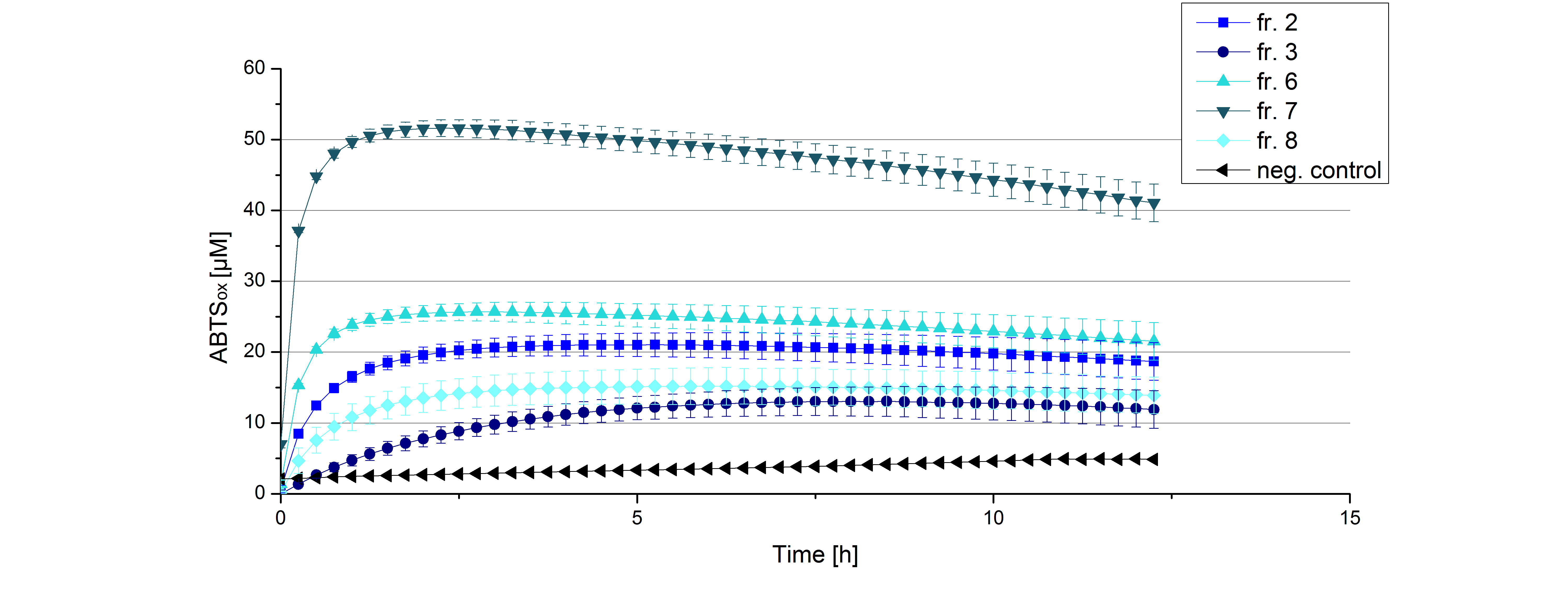
[http://partsregistry.org/Part:BBa_K863005 ECOL] pH optimum
To determine at which pH the [http://partsregistry.org/Part:BBa_K863005 ECOL] laccase has its optimum in activity, a gradient of sodium acetate buffer pHs was prepared. Starting with pH 1 to pH 9 [http://partsregistry.org/Part:BBa_K863005 ECOL] activity was tested using the described conditions above and 0.03 mg mL-1 protein. The results are shown in figure 9. A distinct pH optimum can be seen at pH 5. The saturation is reached after 2.5 hours with 53% oxidization of ABTS through the [http://partsregistry.org/Part:BBa_K863005 ECOL] laccase at pH 5 (53 µM oxidized ABTS) . The other tested pHs only led to a oxdization of up to 17% of added ABTS, respectively. Figure 10 shows the results of the analog experiments with laccase that was not incubated with CuCl2 before the activity measurements. A pH optimum can as well be determined for pH 5. An amount of 24 µM ABTS (24%) is oxidized via [http://partsregistry.org/Part:BBa_K863005 ECOL] after 8 hours.
Figure 11 represents the negative control showing the oxidization of ABTS through 0.4 mM CuCl2 at the chosen pHs. The highest increase in oxidzied ABTS can be seen at a pH of 5. After 5 hours 15% ABTS are oxidized only through CuCl2. Nevertheless this result does not have an impact on the reactivity of the [http://partsregistry.org/Part:BBa_K863005 ECOL] laccase at pH 5, which is still the optimal pH. Therefore it has the same pH optimum as TVEL0.
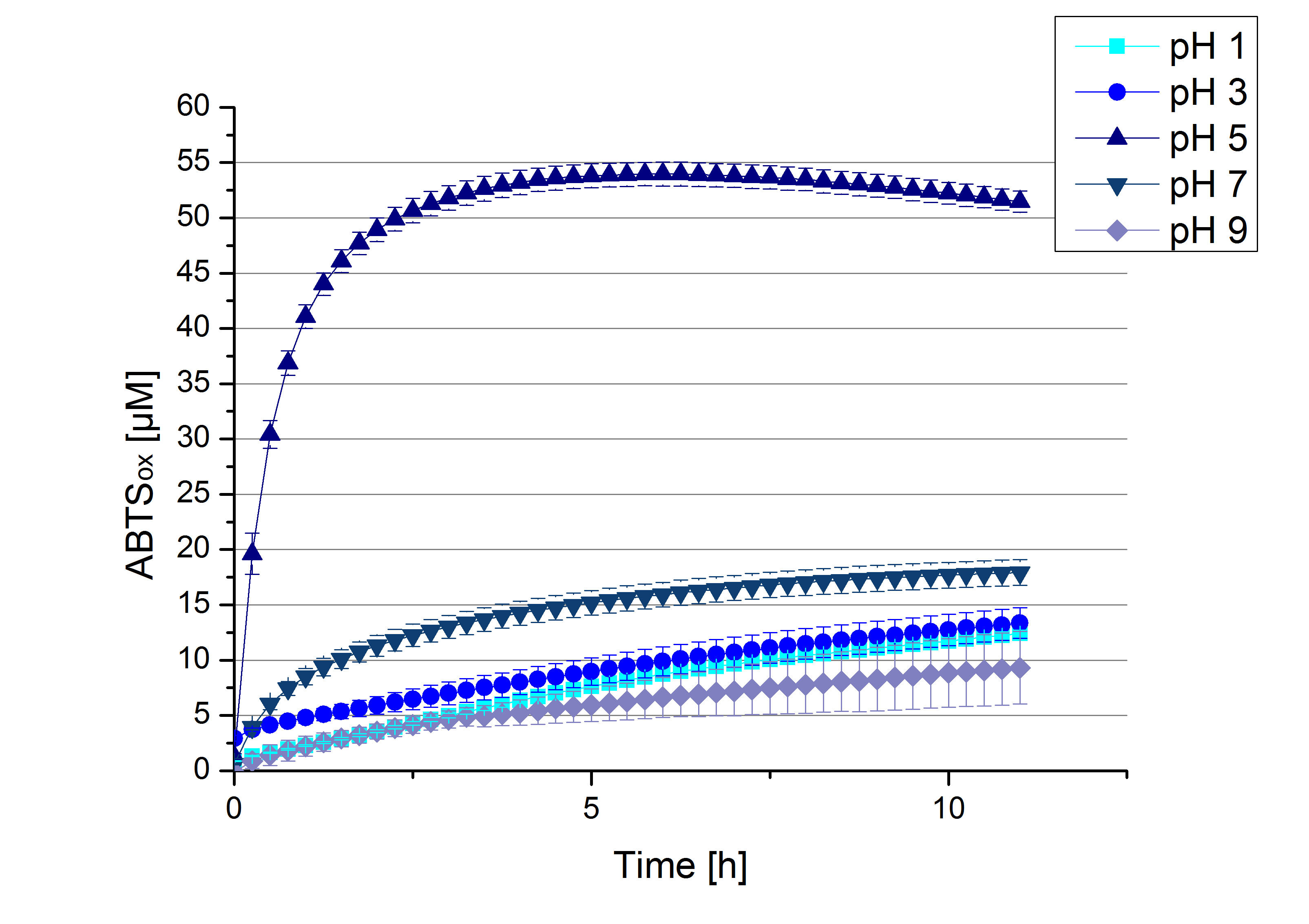
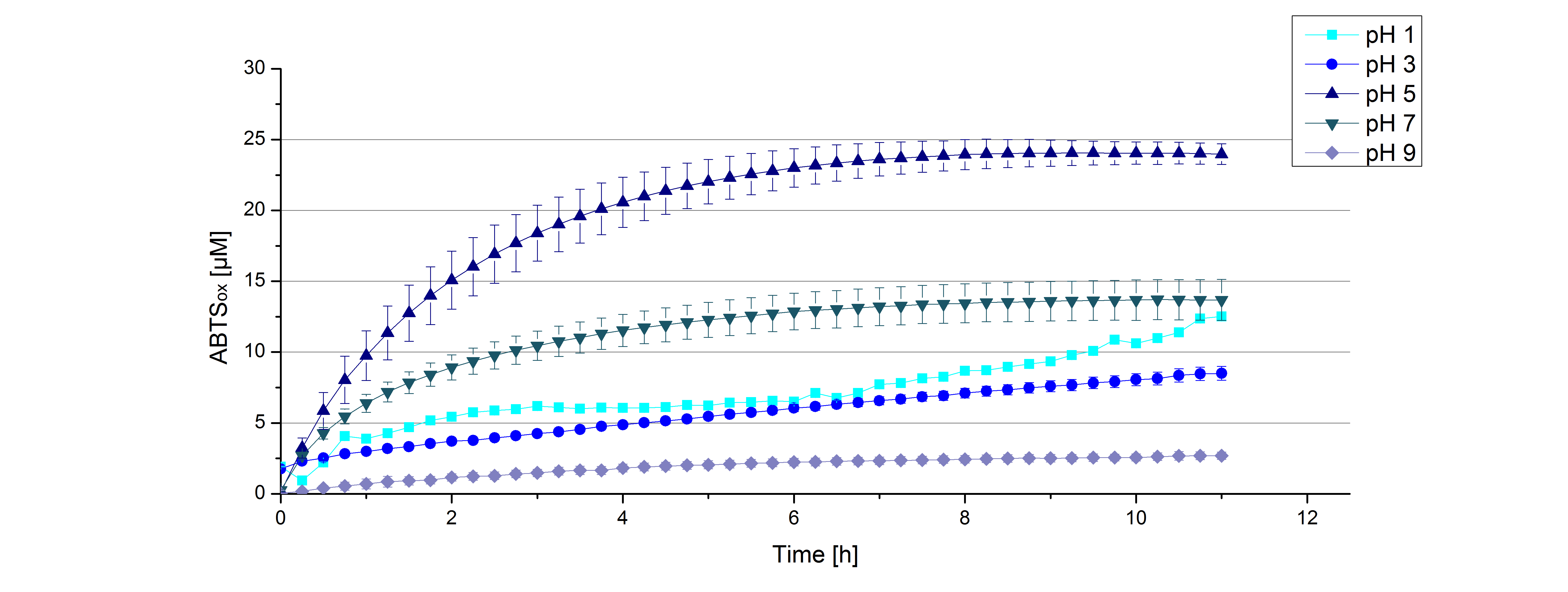
In regard to our project an optimal pH of 5 is a helpful result. Since waste water in waste water treatment plants has a average
pH of 6.9 it has to be kept in mind, that a adjustment of the pH is necessary.
[http://partsregistry.org/Part:BBa_K863005 ECOL] CuCl2 concentration
Another test of [http://partsregistry.org/Part:BBa_K863005 ECOL] was done to survey the best CuCl2 concentration for the activity of the purified [http://partsregistry.org/Part:BBa_K863005 ECOL] laccase. 0.03 mg mL-1 of protein were incubated in different CuCl2 concentration ranging from 0 to 0.7 mM CuCl2. Activity tests were performed with the incubated samples, 100 mM sodium actetate buffer (pH 5), 0.1 mM ABTS, ad 200 µL H2O. The reactivity was measured at 420 nm, 25°C and over a time period of 10 hours. As expected the saturation takes place after 5 hours (see figure 11). The differences in the activity of [http://partsregistry.org/Part:BBa_K863005 ECOL] laccases incubated in different CuCl2 differ minimal. The most percentage is oxidized with [http://partsregistry.org/Part:BBa_K863005 ECOL] laccases incubated with 0.4 mM CuCl2 (42% of added ABTS). With a higher concentration of 0.7 mM CuCl2 the activity seems to be reduced (only 41% ABTS got oxidized). This leads to the assumption that CuCl2 supports the [http://partsregistry.org/Part:BBa_K863005 ECOL] laccase reactivity but concentrations exceeding this value of CuCl2 may have a negative impact on the ability of oxidizing ABTS. Without any CuCl2 application [http://partsregistry.org/Part:BBa_K863005 ECOL] laccases show lesss activity in oxidizing ABTS (see Fig. 10). This fits the expections knowing that laccases are copper reliant enzymes and gain their activity through the incorporation of copper. Additionally negative controls were done using the tested concentrations of CuCl2 but no laccase to detect the oxidization of ABTS through copper (see figure 12). The more CuCl2 was applicated, the more ABTS was oxidzied after 5 hours. Still the maximal change accounts ~6% oxidized ABTS after 5 hours.
In relation to apply the laccase in waste water treatment plants it is beneficial knowing, that small amounts of CuCl2 are enough to activate them. This reduces the cost factor and risks.
[http://partsregistry.org/Part:BBa_K863005 ECOL] activity at different temperatures
To investigate in the activity behaviour of [http://partsregistry.org/Part:BBa_K863005 ECOL] at lower temperature conditions activity tests as described above were done at 10°C and 25°C. A small decrease in the activity can be observed considering the temperature shift from 25°C to 10°C. After 2 hours when samples at 25°C reached the saturation samples at 10°C had not, but nonetheless the difference is minimal. After 3,5 hours 2% difference in oxidized ABTS is observable. The negative control without the [http://partsregistry.org/Part:BBa_K863005 ECOL] laccase but 0.4 mM CuCl2 at 10°C shows a negligible effect on the status of ABTS. A decrease in the reactivity of [http://partsregistry.org/Part:BBa_K863005 ECOL] laccases was expected. Since it is not reduced in a high manner it is applicable for usage in waste water treatment plants where the temperature differs from 8.1°C to 20.8°C.
[http://partsregistry.org/Part:BBa_K863005 ECOL] activity depending on different ABTS concentrations
Furthermore [http://partsregistry.org/Part:BBa_K863005 ECOL] laccases were tested using different amounts of ABTS to calculate KM and Kcat values. The same measurement setup as described above was used only with different amounts of ABTS. As anticipated the amount of oxidized ABTS increased dependent on the amount of used ABTS (figure 14). Especially using 8 µL showed an increase in the reactivity until hour 3 (reaching 200 µM ABTSox. The results of the measurements of the samples tested with 16 µL could not be detected longer than 1.5 h because the values were higher than the detection spectrum of the used device (TecanReader).
Impact of MeOH and acteonitrile on [http://partsregistry.org/Part:BBa_K863005 ECOL]
For substrate analytic tests the influence of MeOH and acetonitrile on [http://partsregistry.org/Part:BBa_K863005 ECOL] laccases had to be determined, because substrates have to be dissolved in these reagents. The experiment setup included 0.03 mg mL-1 [http://partsregistry.org/Part:BBa_K863005 ECOL] laccase, 100 mM sodium actetate buffer, different amounts of MeOH (figure 15) or acteonitrile (figure 16), 0.1 mM ABTS, ad 200 µL deionized H2O. The observed reactivity of [http://partsregistry.org/Part:BBa_K863005 ECOL] in regard of oxidizing ABTS did not reveal a huge decrease. The less MeOH or acetonitrile was used, the higher was the amount of oxidized ABTS after 5 hours. An application of 16 µL MeOH or acetonitrile led to a decrease of maximal 8 to 10% oxidized ABTS compared to 2 µL MeOH or acetonitrile.
| 55px | | | | | | | | | | |
 "
"






